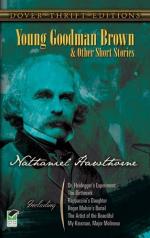|
This section contains 513 words (approx. 2 pages at 300 words per page) |

|
Young Goodman Brown, An Analysis of Themes
Summary: Examines the novel "Young Goodman Brown" by Nathaniel Hawthorne. Describes how Hawthorne's use of ambiguity in the novel allows for a full spectrum of comprehension by readers, allowing the work to have multiple meanings.
Nathaniel Hawthorne, a master of ambiguity, creates works that keep his readers' minds thinking and questioning. Ambiguity is the use of words and/or phrases to bring multiple meanings from figural and literal conceptions. Hawthorne wrote "Young Goodman Brown" with a full spectrum of comprehension by allowing his reader to analyze the reasons for multiple meanings. The reader determines the moral vision that Hawthorne sets forth through the style and tone using ambiguity.
The story of "Young Goodman Brown" begins with an eerie departure of a caring husband, Goodman Brown, from a loving, compassionate wife, Faith. Without giving any such reasons for Brown's excursion, Hawthorne immediately induces curiosity upon the reader's mind; impelling the questions of "why" or "for what reason" does this man leave his beloved wife. As the reader follows along the journey of Brown, numerous occasions of ambiguity arise such as the stranger with the...
|
This section contains 513 words (approx. 2 pages at 300 words per page) |

|


